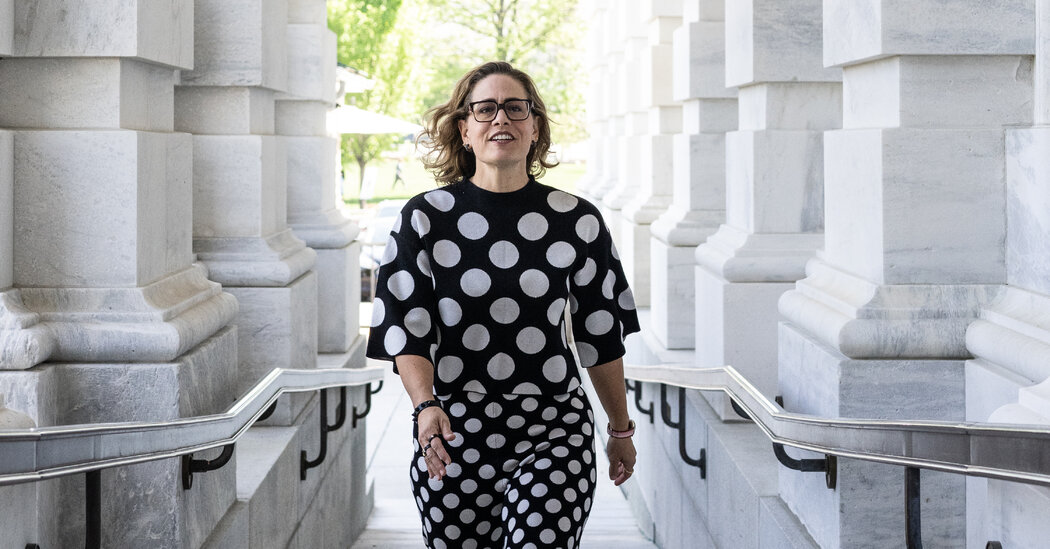Much commentary ensued in February when Romney and Sinema were seen sitting together during Biden’s State of the Union address. What was not widely kn
Much commentary ensued in February when Romney and Sinema were seen sitting together during Biden’s State of the Union address. What was not widely known was that a month earlier, Romney voted against confirming Roopali Desai, an Arizona lawyer, to serve on the U.S. Court of Appeals for the Ninth Circuit. Desai, a prominent election-law attorney who represented Arizona’s secretary of state in 2020 election cases, once served as campaign counsel to Sinema, who had recommended her to Biden’s team. Sinema ran to catch Romney after his vote. She asked him to reconsider, adding that Desai was a personal friend. Romney told me: “She responded to my concerns and convinced me to go back and change my vote. And I wouldn’t do that for just anybody.” Desai would ultimately be confirmed by a vote of 67 to 29, with more bipartisan support than any federal judicial nominee had received in over 20 years.
Sinema told me that Biden’s chief of staff at the time, Ron Klain, had expressed doubts that she could find any Republican support for Desai. It was this lack of faith in Sinema’s abilities that compelled her to later — at a fund-raiser filled with wealthy donors disclosed by Politico — invoke Klain’s name while extending her middle finger. (Klain did not respond to multiple requests for comment.)
Though it has frequently been reported that the independent senator would “continue to caucus with the Democrats,” Sinema told me this was misleading: She almost never showed up to Democratic meetings to begin with, as they tended to be profligate time wasters. Nor does she adhere to the Beltway ritual of appearing on the Sunday talk shows. In her view, they produce only “noise,” though it’s also the case that Sinema’s sometimes cutting utterances do not come off well in such staid settings. Her aversion to publicly revealing her hand differentiates Sinema from Manchin, a voluble regular on the Sunday shows.
Some have inferred from her reticence that Sinema either is incapable of defending her positions or has no actual positions to defend — that she arrives at her decisions capriciously and only after drawing maximum attention to herself. To her friends, like Murphy, the former congresswoman, this view bears more than a whiff of sexism and misses the point: “The fact that she’s playing the inside game, rather than the media game, demonstrates that she’s a professional who shows respect for people, even the ones who’ve disrespected her. If you’re a real legislator and you want to get stuff done, you have to build trust. The minute you call the press or sic the activists on someone to try and apply pressure, you’ve lost that person’s trust.”
I asked Sinema if she found it surprising that someone of her unorthodox character would come to be regarded as a kind of throwback to a less-partisan era, even as a Senate institutionalist. “I think what you’re doing,” she evenly replied, “is you’re mistaking someone who’s not interested in marching to someone else’s drum or following their rules, which are petty and dumb, as being somehow incompatible with wanting to preserve and protect the fundamentals of our democracy.”
One day in 1990, Kyrsten Sinema — 14 years old at the time but considerably younger in appearance — stood before the school board in DeFuniak Springs, Fla., accompanied by her high school guidance counselor, Cynthia Jeselnik. The girl explained that she had already taken every required and honors class her school had to offer. Now she wished to take courses at Okaloosa-Walton Community College (now Northwest Florida State College), 31 miles away in Niceville. Her goal, as Jeselnik would recall to me, “was to graduate early, so that she could get on with her life and with the course she had laid out for herself.”
The young honors student did not have to state the obvious, which was that she saw no future for herself in a rural community with a poverty rate that was close to 25 percent. Nor did she share the particulars of her personal life, with either her counselor or the board: how she had been born into a comfortable middle-class family in Tucson, Ariz., and had nurtured ambitions since she was 6, when she proclaimed to her first-grade teacher that she intended one day to be a U.S. senator and an author; how her world caved in when her father, an attorney, was disbarred for “conduct involving dishonesty, deceit and misrepresentation” in 1983; how the family’s car was subsequently repossessed and her mother, a devout Mormon, left the marriage and became involved with a teacher in the girl’s elementary school; how she, her two siblings, her mother and her new stepfather abruptly left Arizona, driving cross-country to his family’s community in DeFuniak Springs; how the family, with the stepfather struggling to find work, lived for nearly three years in a former gas station, while she and her siblings wore hand-me-down clothes provided by the local Mormon church and ate meals provided by the church and federal food assistance.
www.nytimes.com
